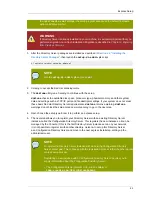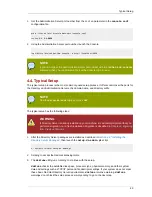
Chapter 4. Setting up Red Hat Directory Server on HP-UX 11i
44
4. Next, choose the setup type. Accept the default, option
2
, to perform a typical setup.
5. Set the computer name of the machine on which the Directory Server is being configured. This
defaults to the fully-qualified domain name (FQDN) for the host. For example:
Computer name [ldap.example.com]:
NOTE
The setup program gets the host information from the
/etc/resolv.conf
file. If
there are aliases in the
/etc/hosts
file, such as
ldap.example.com
, that do
not match the
/etc/resolv.conf
settings, you cannot use the default hostname
option.
The hostname is very important. It is used generate the Directory Server instance name, the
admin domain, and the base suffix, among others. If you are using SSL/TLS or Kerberos, the
computer name must be the exact name that clients use to connect to the system. If you will use
DNS, make sure the name resolves to a valid IP address and that IP address resolves back to this
name.
6. Set the user and group as which the Directory Server process will run. The default is
daemon:daemon
. For example:
System User [daemon]:
System Group [daemon]:
7. The next step allows you to register your Directory Server with an existing Directory Server
instance, called the
Configuration Directory Server
. This registers the new instance so it can be
managed by the Console. If this is the first Directory Server instance set up on your network,
it is not possible to register it with another directory. Select
n
to set up this Directory Server
as a Configuration Directory Server and move to the next typical install step, setting up the
administrator user.
NOTE
To register the Directory Server instance with an existing Configuration Directory
Server, select
yes
. This continues with the registration process rather than the regular
typical setup process.
Registering a new instance with a Configuration Directory Server requires you to
supply information about the Configuration Directory Server:
• The Configuration Directory Server URL, such as
ldap://
ldap.example.com:389/o=NetscapeRoot
To use TLS/SSL, set the protocol as
ldaps://
instead of
ldap://
For LDAPS,
use the secure port (636) instead of the standard port (389), and provide a CA
certificate.






























